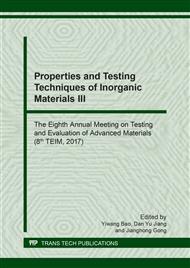[1]
T. Aratani, Y. Nakata, H. Matoba, S. Yasuhara, T. Yano, The removal of heavy metal, phosphate, and COD substances from wastewater by the lime sulfurated solution (calcium polysulfide) process, B. Chem. Soc. Jpn., 51 (1978) 2705-2709.
DOI: 10.1246/bcsj.51.2705
Google Scholar
[2]
W.L. Ling, T.T. Teng, A.F.M. Alkarkhi, A. Ahmad, N. Morad, Optimization of the adsorption conditions for the decolorization and COD reduction of methylene blue aqueous solution using low-cost adsorbent, Water Air Soil Poll., 214 (2011) 185-195.
DOI: 10.1007/s11270-010-0414-0
Google Scholar
[3]
X.M. Tao, G.W. Wang, L.I. X. Xiao, Y.E. Q. Guo, Degradation mechanism of methyl orange by a novel two-level dielectric barrier discharge plasma reactor, Chem. Engin. (2016).
Google Scholar
[4]
S.M.d.A.G. Ulson, K.A.S. Bonilla, A.A.U. de Souza, Removal of COD and color from hydrolyzed textile azo dye by combined ozonation and biological treatment, J. Hazard. Mater. 179 (2010) 35-42.
DOI: 10.1016/j.jhazmat.2010.02.053
Google Scholar
[5]
Z.H. Liu, Y. Kanjo, S. Mizutani, Removal mechanisms for endocrine disrupting compounds (EDCs) in wastewater treatment - physical means, biodegradation, and chemical advanced oxidation: a review, Sci. Total Environ. 407 (2009) 731-748.
DOI: 10.1016/j.scitotenv.2008.08.039
Google Scholar
[6]
B. Rusten, O. Kolkinn, H. Odegaard, Moving bed biofilm reactors and chemical precipitation for high efficiency treatment of wastewater from small communities, Water Sci. Technol. 35 (1997) 71-79.
DOI: 10.2166/wst.1997.0245
Google Scholar
[7]
M. Ksibi, Chemical oxidation with hydrogen peroxide for domestic wastewater treatment, Chem. Engin. J. 119 (2006) 161-165.
DOI: 10.1016/j.cej.2006.03.022
Google Scholar
[8]
O. Türgay, G. Ersöz, S. Atalay, J. Forss, U. Welander, The treatment of azo dyes found in textile industry wastewater by anaerobic biological method and chemical oxidation, Sep. Purif. Technol. 79 (2011) 26-33.
DOI: 10.1016/j.seppur.2011.03.007
Google Scholar
[9]
A. Maezawa, H. Nakadoi, K. Suzuki, T. Furusawa, Y. Suzuki, S. Uchida, Treatment of dye wastewater by using photo-catalytic oxidation with sonication, Ultrason. Sonochem. 14 (2007) 615-620.
DOI: 10.1016/j.ultsonch.2006.11.002
Google Scholar
[10]
Y. Zhu, H. Zhang, X. Zhang, Study on catalytic ozone oxidation with nano-TiO2 modified membrane for treatment of municipal wastewater, Asian J. Chem. 26 (2013) 3871-3874.
DOI: 10.14233/ajchem.2014.15980
Google Scholar
[11]
S. Patnaik, S. Martha, S. Acharya, K.M. Parida, An overview of the modification of g-C3N4 with high carbon containing materials for photocatalytic applications, Inorg. Chem. Fron., 3 (2016) 336-347.
DOI: 10.1039/c5qi00255a
Google Scholar
[12]
S.C. Yan, Z.S. Li, Z.G. Zou, Photodegradation of rhodamine B and methyl orange over boron-doped g-C3N4 under visible light irradiation, Langmuir. 26 (2010) 3894.
DOI: 10.1021/la904023j
Google Scholar
[13]
D. Zheng, C. Pang, Y. Liu, X. Wang, Shell-engineering of hollow g-C3N4 nanospheres via copolymerization for photocatalytic hydrogen evolution, Chem. Commun. 51 (2015) 9706-9709.
DOI: 10.1039/c5cc03143e
Google Scholar
[14]
F. Dong, Z. Zhao, T. Xiong, Z. Ni, W. Zhang, Y. Sun, W.K. Ho, In situ construction of g-C3N4/g-C3N4 metal-free heterojunction for enhanced visible-light photocatalysis, Appl. Mater. Inter. 5 (2013) 11392-11401.
DOI: 10.1021/am403653a
Google Scholar
[15]
Y. Xu, J. Liu, C. Gao, E. Wang, Applications of carbon quantum dots in electrochemiluminescence: A mini review, Electrochem. Commun. 48 (2014) 151-154.
DOI: 10.1016/j.elecom.2014.08.032
Google Scholar
[16]
Q. Liu, T. Chen, Y. Guo, Z. Zhang, X. Fang, Ultrathin g-C3N4 nanosheets coupled with carbon nanodots as 2D/0D composites for efficient photocatalytic H2 evolution, Appl. Catal. B-Environ. 193 (2016) 248-258.
DOI: 10.1016/j.apcatb.2016.04.034
Google Scholar
[17]
S. Zhu, S. Liang, W. Ying, X. Zhang, F. Li, H. Lin, Z. Zhang, X. Wang, Ultrathin nanosheets of molecular sieve SAPO-5: A new photocatalyst for efficient photocatalytic reduction of CO2 with H2O to methane, Appl. Catal. B-Environ. 187 (2016).
DOI: 10.1016/j.apcatb.2016.01.002
Google Scholar
[18]
R. Miao, Z. Luo, W. Zhong, S.Y. Chen, T. Jiang, B. Dutta, Y. Nasr, Y. Zhang, S.L. Suib, Mesoporous TiO2 modified with carbon quantum dots as a high-performance visible light photocatalyst, Appl. Catal. B-Environ. 189 (2016) 26-38.
DOI: 10.1016/j.apcatb.2016.01.070
Google Scholar


